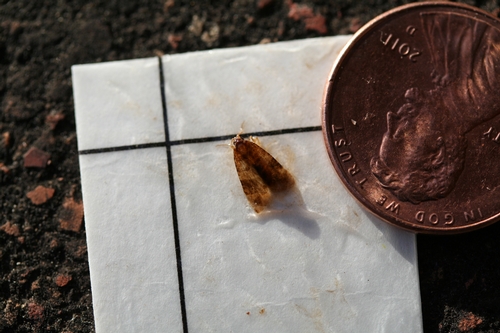Further Comments on the Status of European Grapevine Moth in Santa Cruz County Blackberries
A few more comments on the situation with European grapevine moth in blackberries:
1- European grapevine moth is a surprisingly small moth, as one can see from the picture below. The larvae are also very small, so if you find a leafroller longer than a quarter inch in your blackberries, it is assuredly light brown apple moth or another leafroller and not European grapevine moth.
2- More information on the slim possibility of blackberries as a true host of European grapevine moth. Colleague Lucia Varela has provided me with a paper from the European Journal of Entomology (Stavridis, 1998) finding that European grapevine moth larvae did not survive when reared on blackberry fruit or flowers, but then a doctoral thesis from the Université Bordeaux 2 in 2002 identifies Rubus as a potential host. One of the crucial pieces of evidence for this identification is a book written by a P. Marchal in 1912, which we have not been able to find in order to confirm the citation as legitimate (if any of the readership here knows of a copy please let me know! It's pretty important). Underlining the dubiousness of the blackberry-as-host hypothesis, researchers in Europe, where this pest is native, have never seen European grapevine moth on many of the hosts cited in the work above.
3- A number of fields have been inspected, and as expected all have been found to be negative for European grapevine moth. Additionally, as a testament to the success area blackberry growers have had in controlling light brown apple moth, I have not heard of any finds of that pest either in these inspections. The regulations have been modified a bit now so that growers being inspected for European grapevine moth every thirty days are considered as inspected for light brown apple moth at the same time.
The photo below is of the inspection process (which takes from 20 to 30 minutes), and, as described before in this space, it is fruit by fruit. The inspectors are professionals, very thorough (and friendly too) and there is no doubt they will find larvae if they are present.

Adult European grapevine moth.

